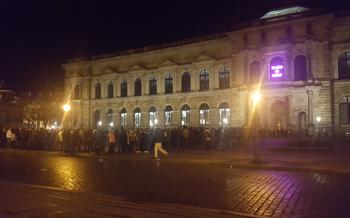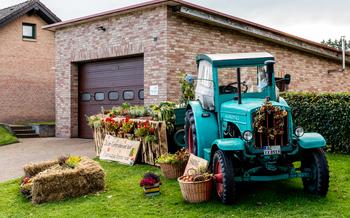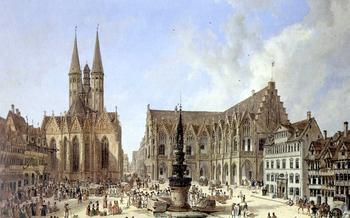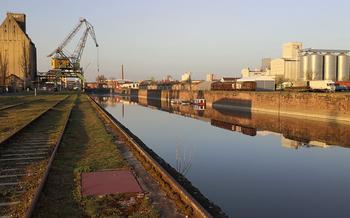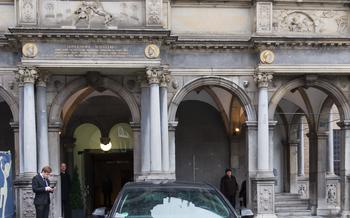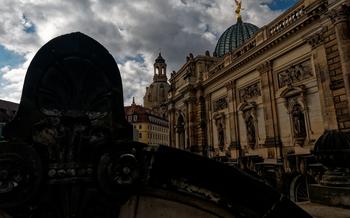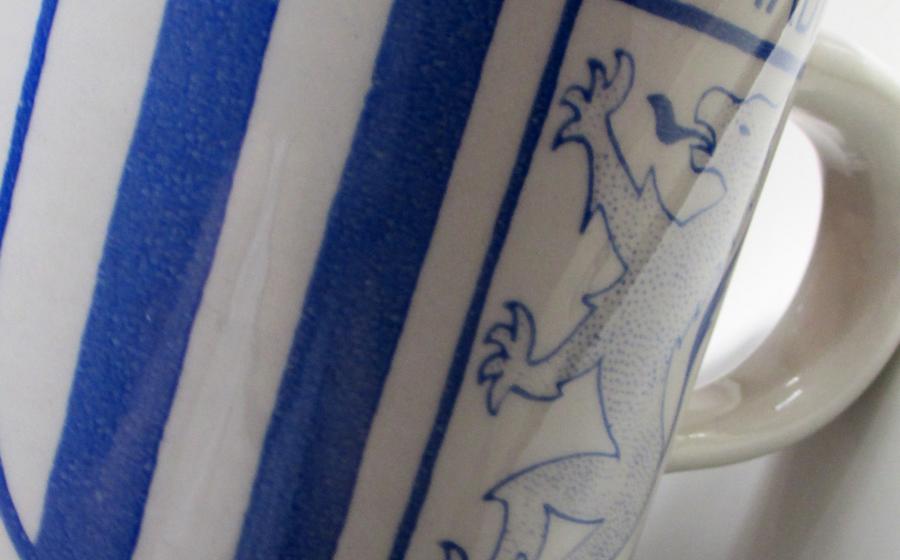
Göltzsch Viaduct
- A Monumental Feat of Engineering:
- Picturesque Surroundings
- Technical Marvel:
- A Walk Through History
- Unique Perspectives
- Engineering Masterpiece
- A Symbol of Resilience
- Cultural Significance
- Nature's Canvas
- Architectural Details:
- Transportation Hub
- Local Cuisine and Hospitality
- Photography Opportunities
- Family-Friendly Adventures
A Monumental Feat of Engineering:
The Göltzsch Viaduct, nestled in the heart of Germany's Vogtland region, stands as a testament to human ingenuity and engineering prowess. Constructed between 1846 and 1851, this stunning railway bridge, with its 98 arches soaring 78 meters above the Göltzsch Valley, is a masterpiece of 19th-century engineering.
The viaduct's construction posed significant challenges. The rugged terrain, coupled with the need to maintain a steady gradient for rail traffic, demanded innovative solutions. Engineers employed a combination of granite blocks and iron components, a pioneering technique at the time. The use of iron allowed for the construction of slender, yet strong arches, reducing the overall weight of the structure.
The Göltzsch Viaduct's significance extends beyond its engineering marvels. It played a pivotal role in the development of transportation and trade in the region. The viaduct's completion in 1851 established a crucial link between the cities of Leipzig and Nuremberg, facilitating the movement of goods and people. Its strategic location made it a vital artery for the transportation of coal and other resources, fueling the industrial growth of the region.
Picturesque Surroundings
The Göltzsch Viaduct resides in the picturesque Vogtland region, a landscape renowned for its lush greenery, rolling hills, and serene valleys. The viaduct gracefully spans the Göltzsch Valley, offering breathtaking views of the meandering river, dense forests, and charming villages nestled amidst the hills.
In the immediate vicinity of the viaduct lies the Göltzsch Valley, a natural paradise that invites visitors to explore its scenic trails, discover hidden waterfalls, and admire the diverse flora and fauna that call this valley home. For an unforgettable hiking experience, embark on the Göltzschtalweg, a well-marked trail that takes you through the heart of the valley, leading you to the foot of the viaduct.
The Ore Mountains, a majestic range that forms the natural border between Germany and the Czech Republic, are another must-see attraction in the region. With its rugged peaks, verdant slopes, and charming mountain towns, the Ore Mountains offer a variety of hiking and biking trails, as well as opportunities for skiing and snowboarding during the winter months.
To delve deeper into the region's history and culture, visit the Vogtland Panorama Museum in nearby Oelsnitz. This immersive museum showcases a 360-degree panorama depicting life in the Vogtland during the 19th century, offering a glimpse into the region's rich traditions and heritage.
For photography enthusiasts, the Göltzsch Viaduct presents a wealth of opportunities to capture stunning images. With its imposing structure set against the backdrop of the picturesque Vogtland countryside, the viaduct offers endless possibilities for creative compositions. Whether you prefer to shoot during the golden hours of sunrise and sunset, or under the starry night sky, the viaduct's beauty shines through in every frame.
Technical Marvel:
The Göltzsch Viaduct, a masterpiece of 19th-century engineering, stands as a testament to human ingenuity and innovation. Constructed using cutting-edge techniques and materials, the viaduct showcases the remarkable vision and skill of its creators.
The viaduct's most striking feature is its innovative use of granite blocks and iron components. While stone viaducts were common at the time, the Göltzsch Viaduct was one of the first to incorporate iron, a relatively new material that offered greater strength and flexibility. This combination of materials resulted in a structure that was both durable and aesthetically pleasing.
The viaduct's impressive statistics speak to its grandeur: stretching over 574 meters (1,883 feet) in length, it stands at a height of 78 meters (256 feet) and comprises 29 arches, each spanning over 16 meters (52 feet). These dimensions make it one of the largest brick viaducts in the world, a true marvel of civil engineering.
The Göltzsch Viaduct played a pivotal role in revolutionizing transportation and trade in the region. Prior to its construction, the steep Göltzsch Valley posed a significant obstacle to travel and commerce. The viaduct's completion in 1851 bridged this gap, allowing trains to cross the valley safely and efficiently. This transformative infrastructure project opened up new economic opportunities, connecting the Vogtland region with major cities and markets, and fostering the growth of industry and tourism.
A Walk Through History
Embark on a journey through time as you explore the Göltzsch Viaduct and its captivating history. Immerse yourself in the stories of the dedicated engineers, architects, and workers who brought this masterpiece to life. Stroll along the designated walking paths, offering breathtaking viewpoints that showcase the viaduct's grandeur against the backdrop of the picturesque Vogtland countryside.
Listen to the echoes of the past as you uncover anecdotes and tales of the people who dedicated their lives to maintaining and preserving this iconic structure. Join a guided tour to gain invaluable insights into the viaduct's construction, its significance in the region's development, and the fascinating stories of those who have crossed its path.
Unique Perspectives
Beyond exploring the Göltzsch Viaduct on foot, there are several other ways to experience its grandeur and appreciate its engineering marvel from different perspectives.
-
A Train Journey Through History: Embark on a nostalgic train ride aboard the Vogtlandbahn, a regional train that traverses the viaduct, offering a unique vantage point as you glide over its arches. Witness the viaduct's impressive height and intricate architecture from the comfort of your seat, while soaking in the scenic beauty of the surrounding countryside.
-
A Bird's-Eye View: For a truly breathtaking experience, consider booking a hot air balloon ride or paragliding adventure. Soaring high above the viaduct, you'll be rewarded with panoramic views of the structure and the picturesque Vogtland region, creating memories that will last a lifetime.
-
Annual Göltzsch Viaduct Festival: Each year, the viaduct becomes the centerpiece of a vibrant festival that celebrates its history and significance. Immerse yourself in the lively atmosphere as you enjoy live music, indulge in delicious food from local vendors, and participate in family-friendly activities. The festival offers a unique opportunity to connect with the local community and celebrate the enduring legacy of the Göltzsch Viaduct.
Engineering Masterpiece
The Göltzsch Viaduct has garnered widespread recognition for its exceptional engineering and architectural achievements. In 2018, it was inscribed as a UNESCO World Heritage Site, solidifying its status as a cultural property of outstanding universal value. The viaduct's designation as a national monument further underscores its significance to German engineering heritage.
Experts and visitors alike have marveled at the viaduct's beauty and grandeur. Renowned architect Gottfried Semper praised the viaduct as "a masterpiece of engineering art," while renowned engineer Carl von Rabenau described it as "a work of art that will endure for centuries." Visitors from around the world have been awestruck by the viaduct's imposing presence and intricate details.
Here are a few quotes that capture the essence of the Göltzsch Viaduct's significance:
"The Göltzsch Viaduct is a testament to human ingenuity and the power of engineering to create structures that are both functional and aesthetically pleasing." - UNESCO World Heritage Committee
"This viaduct is a masterpiece of 19th-century engineering, and it continues to inspire awe and admiration in visitors today." - German National Monuments Foundation
"The Göltzsch Viaduct is a symbol of German engineering excellence and a reminder of the important role that infrastructure plays in our society." - Angela Merkel, former Chancellor of Germany
These accolades and testimonials speak volumes about the Göltzsch Viaduct's enduring legacy as an engineering masterpiece and a source of national pride.
A Symbol of Resilience
The Göltzsch Viaduct has stood the test of time, enduring two world wars and numerous floods, emerging as a symbol of resilience and strength. During World War II, the viaduct was a strategic target for Allied bombers, but it miraculously survived despite several near misses. The viaduct's solid construction and thoughtful design allowed it to withstand the immense forces of nature, including devastating floods that swept through the valley.
The viaduct's resilience is a testament to the skill and ingenuity of the engineers who designed and built it. They understood the importance of creating a structure that could withstand the elements and the demands of heavy rail traffic. The viaduct's foundations are deeply embedded in the bedrock, and its arches are designed to distribute weight evenly, ensuring its stability.
The Göltzsch Viaduct's survival through wars and natural disasters is a reminder of the enduring power of human engineering and the importance of preserving our architectural heritage. It stands as a symbol of hope and resilience, inspiring generations with its steadfast presence.
Cultural Significance
The Göltzsch Viaduct holds a profound cultural significance for the Vogtland region, deeply intertwined with the local identity and heritage. Over the years, it has become an iconic symbol of the region's engineering prowess and a source of pride for its inhabitants.
Local legends and folklore have sprung up around the viaduct, adding to its mystique and allure. One tale speaks of a master builder who made a pact with the devil to complete the viaduct in record time. Another tells of a hidden treasure buried beneath one of the viaduct's arches, waiting to be discovered by a worthy adventurer.
To delve deeper into the region's rich cultural heritage, visitors can explore nearby museums and cultural centers. The Vogtland Museum in Plauen showcases the region's history, traditions, and صنایع دستی. The Museum für Naturkunde Chemnitz offers insights into the region's natural environment and wildlife. By immersing yourself in the local culture, you gain a deeper appreciation for the Göltzsch Viaduct's significance as a symbol of the Vogtland's spirit of innovation and resilience.
Nature's Canvas
The Göltzsch Viaduct stands amidst a landscape that undergoes a remarkable transformation with the changing seasons. In the spring, the valley bursts into life, with vibrant wildflowers carpeting the meadows and trees adorned with fresh foliage. The viaduct becomes a canvas for nature's artistry, as the surrounding greenery creates a picturesque backdrop for this architectural marvel.
During the summer months, the viaduct basks under the warm sunlight, casting long shadows across the valley. The lush vegetation provides a verdant contrast to the viaduct's imposing stone structure, creating a harmonious blend of nature and engineering.
As autumn approaches, the landscape transforms into a kaleidoscope of colors. The leaves of the surrounding trees turn brilliant shades of red, orange, and yellow, creating a breathtaking spectacle against the backdrop of the viaduct's gray granite. The autumnal hues add a touch of warmth and nostalgia to the atmosphere, making it an ideal time to capture the viaduct's beauty.
In the winter, the viaduct takes on a majestic and ethereal appearance. When snow blankets the valley, the viaduct emerges as a solitary sentinel, its graceful arches standing in stark contrast to the white landscape. The snow-covered surroundings create a magical ambiance, transforming the viaduct into a winter wonderland.
Throughout the year, the viaduct offers a dynamic and ever-evolving landscape, providing photographers with endless opportunities to capture its beauty in all its forms. Whether you're a seasoned professional or an amateur enthusiast, the Göltzsch Viaduct is a true photographer's paradise.
Architectural Details:
The Göltzsch Viaduct is a masterpiece of 19th-century engineering, showcasing intricate architectural details that reflect the prevailing styles of the era. Its towering arches, massive pillars, and elegant ornamentation create a visually stunning structure that commands attention. The viaduct's design is a harmonious blend of form and function, with each element contributing to its overall strength and stability.
The rounded arches, reminiscent of Roman aqueducts, are not merely decorative but serve to distribute the weight of the bridge evenly, ensuring its structural integrity. The pillars, adorned with rusticated stonework, rise majestically from the valley below, providing a solid foundation for the viaduct. The intricate corbels and moldings add a touch of refinement to the otherwise austere structure, showcasing the attention to detail and craftsmanship that went into its construction.
The symbolism embedded in the viaduct's architecture is equally captivating. The number of arches, 99, is said to represent the 99 different ways in which the devil tried to sabotage the construction of the bridge, a nod to the local folklore surrounding its creation. The viaduct's alignment with the stars during the summer solstice is another example of its symbolic significance, demonstrating the builders' understanding of astronomy and their desire to create a structure that would stand the test of time.
Exploring the architectural details of the Göltzsch Viaduct is a journey through history and engineering ingenuity. Whether you choose to admire it from afar or take a closer look through guided tours or self-guided exploration, the viaduct's beauty and grandeur will leave you in awe.
Transportation Hub
The Göltzsch Viaduct serves as a crucial transportation link, connecting major cities and regions within Germany. Its strategic location has played a vital role in facilitating trade and travel, contributing to the economic development of the area. Over the years, countless travelers, merchants, and commuters have crossed the viaduct, forging connections and fostering a sense of unity.
The viaduct's construction in the 19th century revolutionized transportation and trade in the region. It enabled the efficient movement of goods and people between Saxony and Bavaria, transforming the area into a thriving commercial hub. The viaduct's ability to accommodate heavy rail traffic made it an indispensable part of the region's infrastructure, enabling the transportation of raw materials, manufactured goods, and agricultural products.
Today, the Göltzsch Viaduct continues to be a vital transportation link, carrying both passenger and freight trains. It forms part of the main railway line connecting Leipzig and Nuremberg, facilitating travel and commerce between these major cities. The viaduct's enduring importance as a transportation hub underscores its role in driving economic growth and connectivity in the region.
Local Cuisine and Hospitality
When visiting the Göltzsch Viaduct, take the opportunity to savor the culinary delights of the Vogtland region. Indulge in mouthwatering dumplings, tantalize your taste buds with smoked meats, and satisfy your sweet tooth with traditional pastries. Local restaurants and cafes offer panoramic views of the viaduct, allowing you to relish a delicious meal while marveling at this architectural masterpiece. Experience the warm hospitality of the locals, who are always ready to share stories and recommendations about the viaduct and the surrounding area. Embrace the chance to immerse yourself in the rich cultural heritage of the Vogtland region, creating lasting memories through your culinary adventures.
Photography Opportunities
The Göltzsch Viaduct presents a photographer's paradise, offering endless possibilities for capturing its grandeur and beauty. For the best results, arrive early in the morning or during the golden hours of sunset to take advantage of the warm, diffused light that highlights the viaduct's architectural details. Experiment with different angles and perspectives to create dynamic compositions. Use a tripod to stabilize your camera and capture sharp images, especially when photographing trains crossing the viaduct. Consider using a wide-angle lens to emphasize the viaduct's scale and majesty or a telephoto lens to isolate specific features and create a sense of intimacy. For a unique perspective, consider booking a hot air balloon ride or a paragliding experience to capture aerial shots of the viaduct and its stunning surroundings. Join a photography workshop or tour to learn from experienced photographers and gain insights into capturing the perfect shot.
Family-Friendly Adventures
Visiting the Göltzsch Viaduct with your family can be an enriching and enjoyable experience. The surrounding area offers a range of attractions and activities suitable for children of all ages.
Take your little ones to the Tierpark Chemnitz, a charming zoo home to over 1,000 animals from around the world. Let them marvel at the majestic lions, feed the friendly goats, and watch the playful monkeys swing through the trees.
For a more interactive experience, head to the Museum für Naturkunde Chemnitz. This natural history museum features captivating exhibits on dinosaurs, insects, and the region's unique flora and fauna. Children will be fascinated by the hands-on displays and educational programs that bring science to life.
The Göltzsch Viaduct area also boasts several family-friendly hiking trails. Choose a route that suits your family's fitness level and enjoy a leisurely walk amidst the picturesque scenery. Along the way, keep an eye out for wildflowers, butterflies, and other wonders of nature.
Pack a delicious picnic and find a spot to relax and enjoy a meal with a view. Many picnic areas are located near the viaduct, offering stunning vistas of this engineering marvel.
To make your trip even more memorable, consider booking a stay at a nearby hotel or guesthouse. This will allow you to fully immerse yourselves in the beauty of the viaduct and the surrounding region, creating lasting memories for your family.
